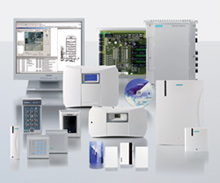Video Surveilance CCTV > System Overview
The modern art of video surveillance
Our video surveillance portfolio ensures you don't miss a thing. These products give you maximum awareness, while minimizing the risk of costly false alarms.
We offer dome and bodied cameras (both with IP variants), lenses, digital video management systems, matrix systems, pan & tilt heads, housings and accessories. As with all Siemens products, the latest manufacturing techniques are used to ensure exceptional quality.
These products are designed to complement our access control and intruder detection portfolios, and are optimized for both installer and end user. Integration with our SiPass access control systems ensures full interoperability as standard. What's more, we provide convenient remote access via web browser or smartphone.
Simplicity, flexibility and reliability. That's the art of security.
Interoperability
Key to the success of any security system is flexibility - flexibility to both upgrade and expand the system. Siemens video surveillance portfolio can be easily expanded as the application needs change and integration with Siemens access control and intruder detection systems, allowing for a complete security system from one supplier.

Electronic security systems from Siemens have inherent interoperability capability, meaning that they easily and quickly interconnect. Thus, regardless of the size of the installation to be protected, no additional development is needed. Consequently, we are reducing installation time, the need for advanced training and eventually maintenance is simplified. The Siemens offering is actually ready to use immediately.
Whether you specify, integrate or install security systems, you need solutions that are flexible enough to meet your requirements of today, whilst allowing for systems to be expanded or upgraded at a later date.
Siemens Video Control products are designed with your requirements in mind and will help you get the best out of your Security System.
CCTV - Analogue or IP?
The fundamental requirements of a video surveilance security system are that it should provide evidental quality images, easy access to recorded data, and a capability to track a target across a specific area. Further security enchancements to a system can also include behaviour recognition systems and the ability to intelligently monitor crowd scenes.
Both Analogue and IP systems can satisfy these requirements very effectively. The table below highlights the different characteristics of an Analogue and IP system to help you decide what system is best suited for your application.
| Analogue system | IP system | |
| System definition | A standard solution incorporates a closed circuit recording system that has monitors, cameras and recorders directly connected to it. The amount of components on the system is limited to the amount of inputs and outputs available. | Unlike an analogue system there is no limit to the amount of components allowed. Utilising an IP network enables integration with other systems including access control and intruder detection, as well as the option for remote monitoring of additional sites. |
| Future proof | Analogue systems are considered well established, resulting in simplified monitoring and configuration. As analogue is considered a mature solution, any future development is likely to be focused around enhancements as opposed to new technology development. | Due to the open technology aspect of IP compared to the closed circuit technology associated with analogue systems, IP components have the capability of greatly increased functionality and higher resolution resulting in greater picture quality. |
| Resolution | Maximum of 625 lines. | Multiple options ranging from VGA to Full HD. |
| Frame rate | 25 frames (PAL) / 30 frames (NTSC). | Multiple options. |
| Data delay | None. | Yes, depending on the bandwidth, network environment and other components utilising the same network. |
| Data deterioration | Yes, depending on the distance the video signal has to travel, and the type of transmission being used. (i.e. Coax, twisted pair etc) | None. |

